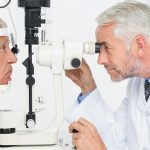The eyes might be the window to the the brain, not the soul as scientists discover that eye tests could soon check for warning signs of dementia… years before symptoms emerge.
Experiments on mice have found brain diseases first manifest themselves in the retina, the light sensing tissue at the back of the eye.
These include Alzheimer’s, a breakthrough that could help discover a cure for the condition.
Scientists say the ability to detect the disease early could be crucial in the search for a drug, as treatments are likely to be more effective before it has taken hold.
In mice genetically engineered to develop Alzheimer’s, researchers observed abnormalities in night vision linked to retinal function.
Specifically, light sensitive cells called rods which enable them to see in the dark were faster at responding to flashes of dim light than in a control group of wild mice.
This may be explained by damage to brain chemicals called neurotransmitters, which is partly behind the deterioration of memory in Alzheimer’s patients.
The researchers said their findings show diseases of the central nervous system may show up in changes in the retina before the brain.
They said the findings suggest an eye examination could be used as a “non invasive screening tool” for brain diseases, including Alzheimer’s.
The retina is an integral part of the central nervous system. If the eyes are a window to state of the brain’s health, diagnostic screening would become more efficient.
In the study Dr Henri Leinonen tracked the eye cells using scanning techniques known as ERG (electroretinography) and VEP (visual evoked potentials).
As well as the dementia results, a mouse model of the central nervous system disorder Huntington’s disease found changes in day and colour vision before the animal had any symptoms.
The research adds to the growing body of evidence that pathological changes in the retina are linked to the central nervous system.
Dr Leinonen, of the University of Eastern Finland, said visual impairment was the fastest progressive symptom in two of the models tested.
In a mouse model of neuronal ceroid lipofuscinosis (NCL), a neurological disease that affects children, the researchers described retinal degenerative changes that mimic AMD (age-related macular degeneration) that can cause blindness in the elderly.
Dr Leinonen said: “Our findings support the idea that for neurodegenerative diseases, which span from the retina to the rest of the CNS, the eye examination serve as a potential screening tool.”
He added: ” Two millenniums ago a philosopher took up a matter that has attracted life scientists now only for decades.
“Cicero, a famous Roman philosopher (106- 34 B.C.) said, ‘The eyes are the window to the soul’. Currently some researchers are on expedition to find out if the popular quote could be extended: the eyes are the window to the soul – and to the brain.”
In the UK there are 850,000 people with dementia, with the number expected to rise to a million by 2025.
by Mark Waghorn
The findings were published in PLoS One, Journal of Alzheimer’s Disease and Human Molecular Genetics.





